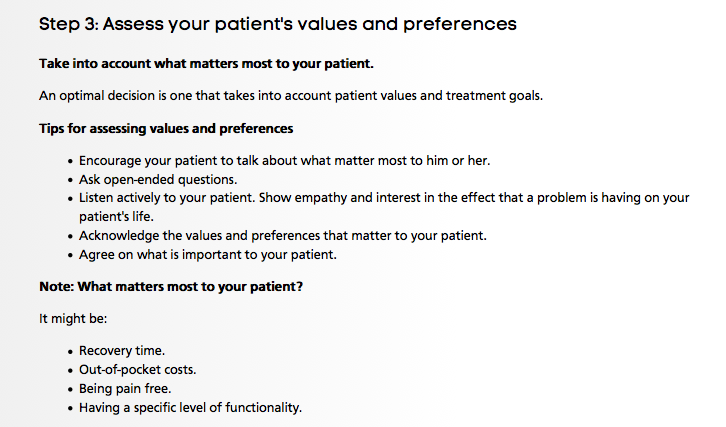Let’s Make Decision Aids More Personal
Shared decision making is a popular concept in the world of patient engagement and personalized health care. It involves a collaborative conversation between patient and provider which allows the patient to make informed treatment decisions based on their needs, desires, and options for care given to them by their provider. The ACA provided avenues for development of decision aids to promote shared decision making as a delivery system reform. For example, shared decision making is one of the delivery improvement models that could satisfy the objectives of research supported by the Center for Medicare and Medicaid Innovation, so we will continue to see research in development of aids to help patients make better treatment choices.
Current research in shared decision making as a healthcare delivery model centers around development of decision aids like the one in the video below, created by Mayo Clinic’s Shared Decision Making National Research Center
While these decision aids are successful in presenting patients with their options for care in an understandable way, which is both important and necessary, they do not do enough to foster the kind of conversation that can lead to a truly effective shared decision based on patient priorities and centered on wellness.
Reference guide materials for providers on shared decision making do a good job of emphasizing that providers should take into account their patient’s values and preferences, as evidenced by Step 3 in AHRQ’s Quick Reference Guide to the SHARE approach for shared decision making, pictured below:

Yet the decision aids themselves are lacking in components to facilitate this kind of discussion or engage the patient in this kind of thinking. By only letting the patient choose from a number of clearly defined options for care, current versions of decision aids miss out on an opportunity to present treatment plans in a way that encourages wellness and connects directly to the patient’s life and lifestyle.
As health systems begin to adopt shared decision making as a part of new delivery models with the goal of controlling cost and increasing patient engagement, they should recognize the potential value in developing more personalized decision aids. Decision aids should do more to connect the patient’s lifestyle priorities with their options for care, engaging the patient in consideration of their values. For example, a decision aid about diabetes treatment options should not only explain the differences between diabetes medications, but also explore how differences in these medications may affect aspects of the patient’s life that are important to them. Especially when it comes to chronic disease management, a decision aid should take into account the ongoing journey of care involved in making treatment or medication decisions.
Because this kind of health decision-making is new to both patients and providers, conversations where the patient’s values are fully expressed and understood are difficult to facilitate, which is why research should pay attention to the kinds of conversations that accompany use of a decision aid. Aids that simply provide comparisons of treatment options may bring about informed decision-making, but this does not ensure that it will be truly shared decision making, or that the resulting decisions made will be relevant and personal to the patient. In a healthcare landscape that emphasizes personalized medicine and care, decision aids shouldn’t feel so impersonal.
